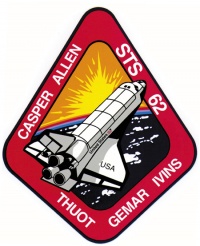STS-62
From The Space Library
 | |
| Organization | NASA-Office of Space Flight (United States) |
|---|---|
| Mission type | Human Crew |
| Launch date | March 9, 1994 |
| Launch vehicle | Space Shuttle |
| Launch site | Cape Canaveral, United States |
| COSPAR ID | 1994-015A |
| Inclination | 39 degrees |
| Experiments | Here |
| Alternate Names | 23025 |
| Additional Information | Here |
| Data Collection | Here |
| Payload Mass Up | 8870 kg |
| Payload Mass Down | 8889.09 kg |
| Orbiter | Columbia |
| Lift Off Mass | 2,054,230.91 kg |
| Orbiter Weight at Liftoff | 116,402.73 kg |
| Orbiter Weight at Landing | 103,064.55 kg |
| Landed | Concrete runway 33 at Kennedy Space Center, Fla. |
| Orbits of Earth | 224 |
| Orbital Altitude | 160 nautical miles (184 statute miles) |
Contents |
[edit] Crew
- Commander: John H. Casper
- Pilot: Andrew M. Allen
- Payload Commander:
- Mission Specialist 1: Pierre J. Thuot
- Mission Specialist 2: Charles D. "Sam" Gemar
- Mission Specialist 3: Marsha S. Ivins
- Mission Specialist 4:
- Mission Specialist 5:
- Payload Specialist 1:
- Payload Specialist 2:
ISS/Mir Crew Transport
[edit] Mission
STS 62 was a US Shuttle spacecraft launched from Cape Canaveral. It carried a US Microgravity Payload (USMP-2) and an Office of Aeronautics and Space Technology Second payload (OAST-2). Among the experiments were the Solar Array Module Plasma Interaction Experiment (SAMPIE), the Thermal Energy Storage (TES) experiment, the Experimental Investigation of Spacecraft Glow (EISG) experiment, the Spacecraft Kinetic Infrared Test (SKIRT) experiment, the Emulsion Chamber Technology (ECT) experiment, and the CRYOgenic Two Phase (CRYOPT) experiment. A new high-speed, Ku-band communication link between mission control and the shuttle enabled transmission of 162 megabytes of data. The crew also conducted number of biomedical activities aimed at better understanding and countering effects of prolonged spaceflight. The two-week mission ended on March 18, 1994.
[edit] EVA
[edit] Payload
United States Microgravity Payload (USMP) 2; Office of Aeronautics and Space Technology (OAST) 2; Dexterous End Effector (DEE); Shuttle Solar Backscatter Ultraviolet/A (SSBUV/A); Limited-Duration Space Environment Candidate Material Exposure (LDCE); Advanced Protein Crystal Growth (APCG); Physiological Systems Experiment (PSE); Commercial Protein Crystal Growth (CPCG); Commercial Generic Bioprocessing Apparatus (CGBA); Auroral Photography Experiment Phase B (APE-B); Middeck Zero-Gravity Dynamics Experiment (MODE); Air Force Maui Optical Site (AMOS) Calibration Test; Bioreactor Demonstration System A
[edit] Books about the Space Shuttle Program
Buy This Book Click here |
Buy This Book here |
Buy This Book Click here |
Buy This Book Click here |





